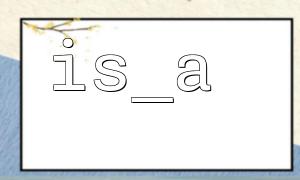在PHP开发中,经常会遇到需要判断一个类是否实现了某个接口的情况。虽然PHP提供了多种方法来实现这个需求,但结合is_a()和interface_exists()函数可以让检测更加准确和安全。本文将详细介绍这两个函数的作用及其联合使用的方法。
is_a()函数用于判断一个对象是否是某个类或接口的实例。它的语法如下:
bool is_a(object|string $object_or_class, string $class_name, bool $allow_string = false)
$object_or_class:可以是对象实例或类名(当第三个参数为true时)。
$class_name:要检测的类名或接口名。
$allow_string:是否允许第一个参数为字符串类名。
示例:
class MyClass implements MyInterface {}
interface MyInterface {}
$obj = new MyClass();
var_dump(is_a($obj, 'MyInterface')); // bool(true)
is_a()可以直接判断一个对象是否实现了某个接口,也可以判断类与接口的继承关系。
interface_exists()函数用于判断某个接口是否已经定义,语法如下:
bool interface_exists(string $interface_name, bool $autoload = true)
$interface_name:接口名称。
$autoload:是否允许自动加载接口(默认true)。
示例:
if (interface_exists('MyInterface')) {
echo "接口存在";
} else {
echo "接口不存在";
}
这个函数在调用is_a()之前检查接口是否存在,可以避免因接口未定义而导致的错误。
单独使用is_a()判断时,如果接口不存在,会导致意料之外的结果。为避免这种情况,推荐先用interface_exists()确认接口是否定义,再用is_a()判断实现关系。
示例代码:
$className = 'SomeClass';
$interfaceName = 'SomeInterface';
if (interface_exists($interfaceName)) {
if (is_a($className, $interfaceName, true)) {
echo "$className 实现了接口 $interfaceName";
} else {
echo "$className 没有实现接口 $interfaceName";
}
} else {
echo "接口 $interfaceName 不存在";
}
这里的重点是:
interface_exists()确保接口存在。
is_a()第三个参数设置为true,允许第一个参数是类名字符串。
结合这两个函数避免了接口不存在时的潜在错误。
假设我们有以下接口和类:
interface LoggerInterface {
public function log($message);
}
class FileLogger implements LoggerInterface {
public function log($message) {
echo "Log to file: $message";
}
}
我们想判断类FileLogger是否实现了LoggerInterface:
$class = 'FileLogger';
$interface = 'LoggerInterface';
if (interface_exists($interface)) {
if (is_a($class, $interface, true)) {
echo "$class 实现了接口 $interface";
} else {
echo "$class 没有实现接口 $interface";
}
} else {
echo "接口 $interface 不存在";
}
输出:
FileLogger 实现了接口 LoggerInterface
确保接口名和类名的拼写正确。
is_a()允许第三个参数为true时,传入类名字符串。
如果只传对象实例给is_a(),则第三个参数默认false。
使用interface_exists()防止接口未定义导致的错误。
通过联合使用is_a()和interface_exists(),你可以更加安全、准确地判断一个类是否实现了指定的接口。这种做法适合大型项目中的动态类型检查,保证代码的健壮性。





